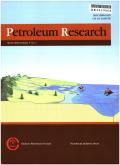印度段马纳尔含油气海湾的形态、水深、重力分析和活动构造
IF 4
Q1 Earth and Planetary Sciences
引用次数: 0
摘要
马纳尔湾的斯里兰卡部分一直在生产天然气。这表明,在海湾的印度部分进行详细的地球科学研究将对印度石油地球科学产生深远的影响。在这项工作中,对陆地附近的海湾/盆地进行了形态测量和重力研究,并对印度部分的Mannar盆地的海上部分进行了水深测量研究。通过对岸区遥感影像8个地貌参数的研究,圈定了5个流域。在这些流域中,有四个和五个被发现是目前构造最活跃的。在今后的钻井作业中,需要考虑井眼稳定性问题。我们进一步绘制了海上研究区的区域等高线图,分析了陆上区域的自由空气重力数据,并推导了第一垂直导数(FVD)和倾斜导数比(TDR)。水深高度从研究区沿海地区向中部地区沿南北方向逐渐增大,重力量级呈现非常陡的梯度(约150 mGal)。重力异常在陆架(包括流域1和流域3部分)处为正(0 ~ 160 mGal),在盆地处为负(- 20 mGal)。近海重力负异常可能预示着油气的存在,但需要更多的研究来证实。显然,地表高程与自由空气重力量级之间几乎呈负相关(分水岭1除外)。本文章由计算机程序翻译,如有差异,请以英文原文为准。
Morphometry, bathymetry, gravity analyses and active tectonics of the petroliferous Gulf of Mannar in the Indian sector
The Gulf of Mannar has been producing natural gas in the Sri Lankan portion. This indicates that a detail geoscientific study is to be undertaken from the Indian section of the gulf, which can have a far-reaching implication in the Indian petroleum geoscience. In this work, morphometric and gravity studies were made from the gulf/basin near the onshore area, and bathymetric studies from the offshore portion of the Mannar basin within the Indian sector. Five watersheds were delineated based on study of eight geomorphic parameters on remote sensing images form the onshore area. Out of these watersheds 4 and 5 are found to be presently tectonically most active. Well-bore stability issue is to be considered while drilling these portions in future. We further prepared a regional contour map for the offshore study area, analysed the free air gravity data from the onshore area, and deduced the First Vertical Derivative (FVD) and Tilt Derivative Ratio (TDR). Bathymetric height gradually increases along the north-south trend from the coast region of the study area towards the central region, while the gravity magnitudes display a very sharp gradient (around 150 mGal). The gravity anomaly shows positive values at continental shelf (0–160 mGal), which includes parts of watersheds 1 and 3 and attains negative magnitude (up to −20 mGal) towards the basin area. Negative gravity anomaly in the offshore area may indicate presence of hydrocarbon but more studies are needed for confirmation. Apparently, almost a negative correlation (except watershed 1) between surface elevation and free air gravity magnitudes has been found.
求助全文
通过发布文献求助,成功后即可免费获取论文全文。
去求助
来源期刊

Petroleum Research
Earth and Planetary Sciences-Geology
CiteScore
7.10
自引率
0.00%
发文量
90
审稿时长
35 weeks
 求助内容:
求助内容: 应助结果提醒方式:
应助结果提醒方式:


